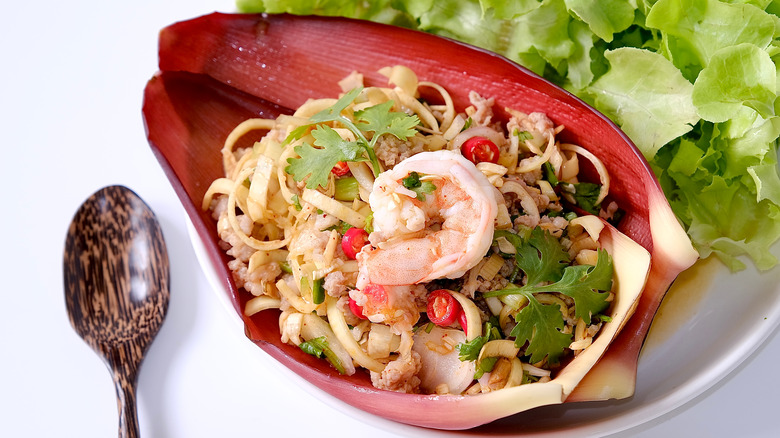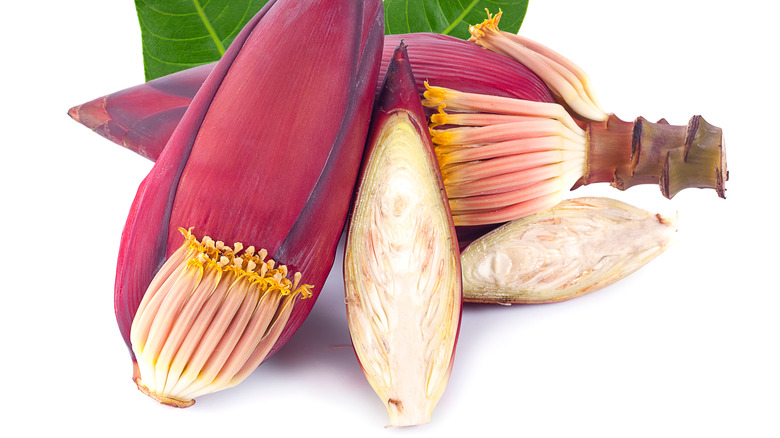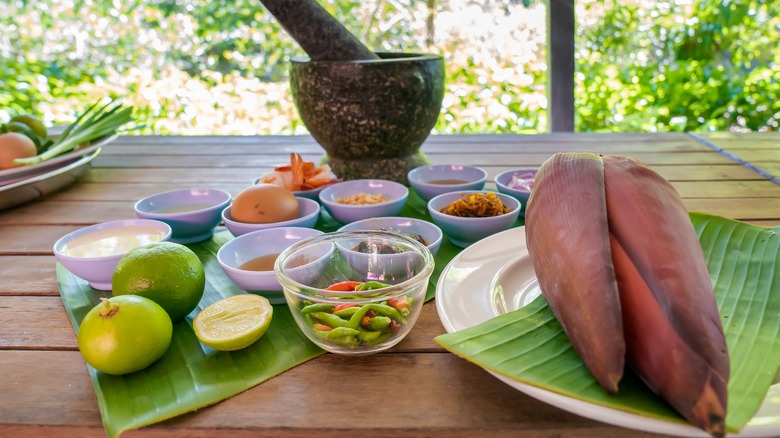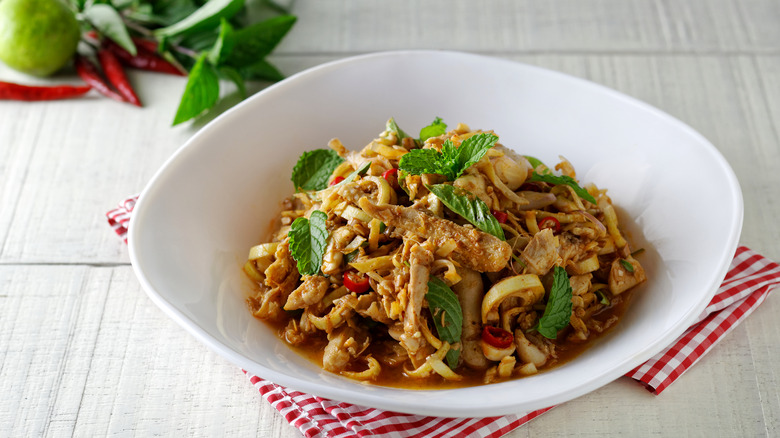Yum Hua Plee: The Delicious Thai Salad With A Unique Ingredient
Sometimes a coleslaw hits the spot, but there's so much more to the world of salads. Whether it's throwing lettuce on the grill for extra flavor or using salad as a vehicle for crispy pork belly, there are numerous methods to reinvent leafy greens. In Thailand, incorporating protein into a salad is nothing new — the dish is hardly a side, but rather an essential component of a meal.
Thai salads are dependably full of flavor. The cuisine blends sweet, salty, sour, and spicy elements, and combines with the abundant use of herbs and spices, per Mae Jum. While the ubiquitous Som Tum, a papaya salad served streetside, maybe the most popular, make sure to sample Yum Hua Plee, too. Made with banana blossoms, coconut milk, chilies, and lime, the delectable dish delivers an array of flavors mixed with the flowers, per Expique. Let's dive into this unique salad.
What is a banana blossom?
Thai banana blossom salad centers on its namesake — the purple flowers growing from the end of a banana plant. Known as Hua Plee in Thai, the edible blossom is what gives the salad its name. Hua Plee is picked earlier than bananas, which mature from small florals surrounding the large flower. The blossom can be boiled, fried, preserved, or eaten raw, reports Import Food.
For the salad, the flower is not cooked. Instead, the rigid outer purple leaves are removed, and the soft flesh is then spritzed with lime juice. After being cut into the intended pieces, it's deposited into a bowl with cold water and more lime juice. Right before mixing with other salad components, the blossom is squeezed of moisture. Maintaining an acidic environment for the flower is necessary to ensure the flesh doesn't darken, notes Thai Fooding. For an easier approach, opt for canned banana blossoms instead of fresh ones. In this form, they can simply be chopped up, although the flavor is dulled. Search for these edible flowers in Asian stores, as well as vegan grocers– this artichoke-like texture is an increasingly popular substitute for fish, per Ceres Organic.
How to prepare Yum Hua Plee
Yum Hua Plee delights with varying textures and flavors — a contrast of tender banana blossoms with crispy toppings. The dressing consists of a creamy coconut base punctuated with acidic additions like lime juice, fish sauce, and tamarind. Toasted coconut is a common addition for a crispy component, such as in a rendition by SBS with prawns.
J. Kenji López-Alt opts for poached chicken as a protein base and builds flavor by frying shallots, garlic, lime leaves, lemongrass, and peanuts. His dressing combines acidic elements with chilies and garlic for an extra kick. In addition to the flowers, he adds mint and cilantro for herbal undertones, per Serious Eats.
Besides the technique of soaking banana blossoms in a lime-water mixture, Yum Hua Plee assembles like any other salad. Components are tossed in a bowl with the dressing, and the fried garnishes are topped at the end. It's common for the salad to be served in a banana flower petal, via Asian Inspirations. The banana blossoms and a coconut-cream-based dressing are the salad's fundamental components– everything else is malleable.
Yum Hua Plee variations
Origins of this Yum Hua Plee point towards the Central Plains of Thailand, where it's also prepared with dried squid, frog meat, and grilled chicken, reports Traditional Thai Food. In Vietnam, another unrelated banana blossom salad is called Nộm hoa chuối. Made with bean sprouts, papaya, and a white-vinegar dressing containing spices, the addition of pork and chicken is common, but just like its Thai counterpart, not always mandatory, via Taste Atlas. In Cambodian cuisine, salads with banana flowers are also common.
Known as Gnoam Trayong Chek, the dish is typically homemade; not commonly consumed as street food. This Khmer version fuses components from its neighbors — an acidic, garlic, and chili dressing, yet without coconut cream. Poached chicken is a common addition, but vegetarian renditions are widespread, too, reports grantourismo. So, when making Yum Hua Plee, do as the chefs in Southeast Asia do. Reach for the freshest herbs, and experiment with dressings — soon, a version will become your own.



